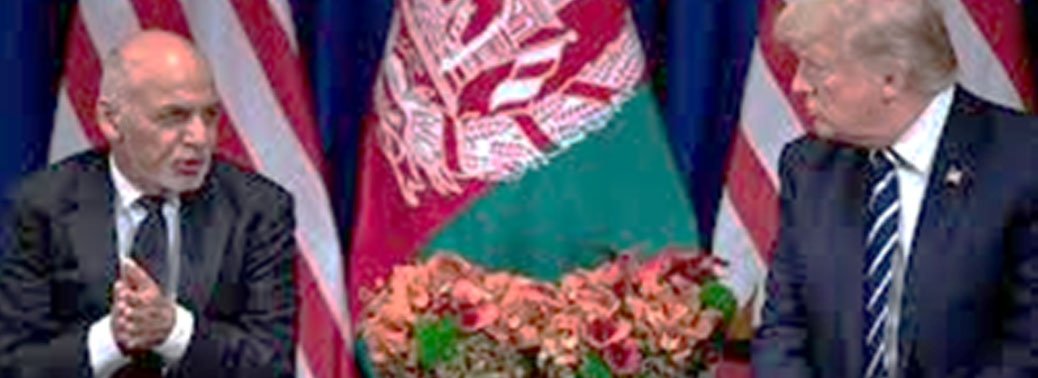Category: India and Pakistan
US – TALIBAN PEACE PACT & INDIA
27, Feb 2020

Context:
- The US administration and the Taliban negotiators have agreed to finalise a peace pact on February 29 if a seven-day cooling-off period was passed off peacefully. The reduction in violence is seen as a test of the Taliban’s control of their ranks and their commitment to peace.This peace deal would be the first step towards US’s withdrawal from the Afghan soil.
The Peace deal and Afghan’s future:
- The peace deal is expected to kick off two processes — a phased withdrawal of US troops and an ‘intra-Afghan’ dialogue.
- The first test will be a “significant reduction in violence” across Afghanistan.
- “Intra-Afghan negotiations will start soon thereafter, and will build on this fundamental step to deliver a comprehensive and permanent ceasefire and the future political roadmap for Afghanistan.
- The only way to achieve a sustainable peace in Afghanistan is by bringing together the main political actors – the Afghan government and the Taliban on the same page.
- However, many security analysts have criticised the US-Taliban talks as it would legitimise the Taliban.
The Taliban and Afghanistan’s Troubled Peace:
- Taliban is an Islamic fundamentalist terror outfit originating in Afghanistan, waging war in the country in the form of an insurgency.
- Taliban emerged in the aftermath of the Afghan Civil War in 1994 and had established dominance in Afghanistan until they were ousted in 2001 after the American invasion.
- The Taliban has been condemned internationally for brutal treatment of many Afghans especially women.
- The UN has accused Taliban of starving the Afghan population by denying them UN food supplies and burning vast areas of fertile land.
- In areas they controlled the Taliban issued edicts which forbade women from being educated and girls were forced to leave schools and colleges.
- Taliban has also been accused of sheltering terrorists that were involved in the 9/11 terror attacks and have claimed responsibility for multiple terror attacks within the country as well as outside.
- Post 9/11 the group has focused more on pushing forward their political and ideological goals by expanding links to other terror outfits like Al-Qaeda and more recently ISIS.
US withdrawal and impact on India:
- India has an investment of over 3 billion dollars in Afghanistan.
- India’s interest is to secure the investments it has made in Afghanistan in the past two decades, and the security of its diplomats, personnel and missions.
- India is helping the Afghan state in the rehabilitation process. This has taken away the large number of Afghan youth from the path of terrorism.
- India wants an Afghan led, controlled, owned process in which all stakeholders have a role to play.India’s position has always been that it does not have any direct conversation with the Taliban.
- However, in 2018, India sent two retired diplomats, at the non-official level to join negotiations with Taliban at Moscow.
- India stresses on the legitimate democratically elected government in Afghanistan.
- India is seen as a stabilizing force by Afghanistan which can keep a check on Pakistan.
- In addition, India is concerned about the ungoverned spaces in that country, which could become grounds for terror groups to flourish.
- Of particular concern would be the prospect that Pakistan could use any such spaces to move its anti-India terror infrastructure, groups like LeT and JeM from Pakistan.
The Pakistan Factor:
- Pakistan has been pressured by the US to bring the Taliban to the negotiating table and prima facie, it has delivered.
- Pakistan tends to utilize the space to project its influence over the Afghan political space and inturn use it as a leverage to come out of the FATF’s grey list.
- However, once when the Taliban enters a power sharing agreement with the Afghan government as part of the US Peace Process, Pakistan may lose its control over the Talibans.
- Pakistan has been providing continuous support to the destabilising elements in Afghanistan, despite the US aid withdrawal. The status-quo is about to change with the Afghan peace deal progress.
Way Forward:
- Making truce only with the Taliban is however a short-sighted policy, an overall dialogue needs to take place among all the stakeholders in Afghanistan to ensure sustainable peace,
- The other countries need to keep their respective interests aside, to build peace in the region.
- The US needs to make its policy on terror in Afghanistan clear, post the afghan withdrawal.
- India and Central Asian Republics can come forward in the rebuilding process to ensure peace in the region.
PAKISTAN OPENS AIRSPACE; HOW THIS WILL IMPACT INDIAN AIRLINES?
16, Jul 2019

- Context: Pakistan opened its airspace for the first time since February 26. The country had imposed restrictions on its airspace in response to the non-military counter-terrorism airstrike by the Indian Air Force against terror camps in Balakot.
- A NOTAM, or Notice to Airmen, was last issued by the Pakistani Civil Aviation Authority closing the airspace.
- This was cancelled early on 16th July, effective around 1 am Indian Standard Time (IST). According to flight tracking portal Flightradar24, several inbound Air India flights from Europe were using routes passing through the Pakistan airspace to return to Delhi.
Impact Of Such Move By Pakistan:
- The move is expected to result in the reduction of flight times by around 70-80 minutes for flights that earlier used Pakistan’s airspace for transit.
- Indian carriers lost crores of rupees due to the restrictions that had resulted in longer flight times and higher fuel burns. Initially, Pakistan had completely closed its airspace. However, it later relaxed the restrictions on overflying the country partially. Out of the total 11 air routes in Pakistan’s territory, it has opened up two since March. One of these is westbound waypoint over Arabian Sea towards Karachi, Hingol, Gwadar, and the other one is eastbound over Karachi, Badin into Gujarat, India towards Ahmedabad.
Routes affected by Pakistan Restrictions on Airspace:
- The closure of routes affected hundreds of east-west flights flying over the subcontinent but westbound flights from airports in northern India such as Delhi, Lucknow, Amritsar etc have been worst affected.
- Due to the closure of routes that allowed westbound flights from airports in north India to enter Pakistani airspace — instead of taking a detour to Gujarat or Maharashtra and then turning right for Europe, North America or West Asia — most flights had seen their durations rise by at least 70-80 minutes. Air India’s flights from Delhi to Chicago had a planned stoppage in Europe for refuelling. Further, IndiGo’s flight from Delhi to Istanbul, which was to be the first non-stop flight on route by an Indian carrier was forced to make a refuelling stop at Doha. Similarly, SpiceJet, which was only Indian airline flying the Delhi-Kabul route had cancelled the flight.
LOW TACTICS: ON INDIAN EMBASSY’S IFTAR PARTY IN ISLAMABAD
05, Jun 2019

Why in News:
- India has issued a public statement of protest over the harassment of guests attending an Iftar party hosted by the Indian High Commission in Islamabad.
Details:
- Guests were allegedly intimidated and stopped by Pakistani security force personnel from attending the event. Last winter, for example, Pakistan authorities refused to give clearances for gas connections for heating in the Indian High Commission’s residential complex in Islamabad, despite the biting cold.
- While Indian authorities reportedly blocked construction workers from entering the Pakistani residential complex in New Delhi to undertake urgent repair work.
- This cycle of undiplomatic behaviour simply vitiates an atmosphere already fraught with tensions, and must end.
- Post-elections, the Indian Air Force has removed airspace restrictions, and Pakistan has begun to open airspace routes to and from India that it had closed after the Pulwama attack. Such positive steps need to be augmented. Earlier, Pakistan granted former External Affairs Minister Sushma Swaraj permission to fly over its territory, and India made a similar concession to Pakistan’s Foreign Minister. India and Pakistan have extremely serious issues to resolve. The harassment of diplomats and their guests is a diversion from the issues at hand.
- With a new government assuming charge in India, and a possible meeting between Prime Minister Narendra Modi and Pakistan Prime Minister Imran Khan at the Shanghai Cooperation Organisation, it is likely that both sides will try to turn the page in bilateral ties.
INDIA, AUSTRALIA TO ADOPT CLASSIFIED COMMUNICATIONS
12, May 2019

Why in News:
-
Australian Navy is, at present, “hanging off” COMCASA — India’s secure communications
agreement with the U.S. — Australia
Background:
- India moving to classified communications environment that one would see, for instance, in the Combined Task Force 150, 151 and 152 operations, where there’s a bunch of like- minded countries that have a communications system that is operating at the classified level, to be able to allow them to talk together.
Relation between India and Australia:
- The establishment of India-Australia Joint Ministerial Commission (JMC) in 1989 encouraged dialogue at a government and business level on multiple issues of trade and investment.
- India-Australia CEO Forum is a significant mechanism through which business leaders from both nations engage in mutually fruitful dialogue to enhance bilateral trade and investment relationship. The Forum consists of heads of Indian and Australian business from multiple sectors like energy and resources, agri-business, financial sector, telecommunications, IT, education and pharmaceuticals. The last meeting of the Forum was held in New Delhi on 29th August 2017.
- The city of Canberra, Australia hosted the seventh India-Australia Economic Policy Dialogue during 16-18 July 2017.
- India s main exports to Australia are passenger motor vehicle and machinery, pearls, gems and jewellery, medicaments (including veterinary) and refined petroleum products.
- India s major imports from Australia are coal, non-monetary gold, copper, wool, fertilizers, wheat, vegetables and education-related services.
- In 2016, India s trade in goods and services with Australia was about US$ 15.6 billion. In 2016, India s export to Australia was about US$4.6 billion.
- In 2016, India s import from Australia was about US$11 billion.
- The two countries are also involved in the RCEP (Regional Comprehensive Economic Partnership) negotiations.
- Indian companies have invested in Australian mining sector successfully.
- India is the fifth largest export market for Australia and tenth largest trading partner overall.






